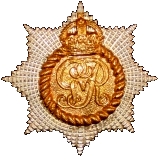
The First World War
Soldiers and Non-Commissioned Officers
of The Royal Canadian Regiment
214215 Pte John Leonard Shook
Negligent Discharge, circa 1918
By: Captain Michael M. O'Leary, orginally published in the regimental journal of The Royal Canadian Regiment, PRO PATRIA 2007
John Leonard Shook was born 7 Dec 1888 at Springfield, Ontario. A mechanic, Shook was a Canadian living at Detroit, Michigan, USA, when he attested for service with the CEF. Shook claimed no prior service with any military force. He was married to Mrs. L. Margret Shook, who was residing at 1305 Dundas St E., London, Ontario. At the age of 28 years, 5 months, he was 5 feet 8 inches tall, with a fair complexion, brown eyes and dark hair. 214215 Private John Leonard Shook attested for the 99th Canadian Infantry Battalion of the Canadian Expeditionary Force (CEF) on 1 April 1916 at Windsor, Ontario.

First World War medals awarded to 214215 Private J.L. Shook.
Shook embarked for Europe at Halifax, Nova Scotia, on 31 May 1916, sailing aboard the S.S. OLYMPIC. Shook disembarked at Liverpool, England, on 8 Jun 1916. Once in England, the 99th Can. Inf. Bn. (known as the "Essex Battalion") was absorbed into the 35th battalion on 6 Jul 1916. Shook's record shows that he was among those soldiers who transferred that day to the 35th Battalion.
Shook remained with the 35th Battalion for the rest of 1916, transferring to The RCR on 22 Dec 1916. He landed in France the following day, and joined the Canadian Base Depot until he joined the unit. A month later, on 20 Jan 1917, John Shook joined a draft heading to the Front and departed the C.B.D. He arrived at the unit lines three days later and was taken on strength, The RCR, in the field on 23 Jan 1917, as the Regiment proceeded to Divisional Reserve at Mont St. Eloy.
Private Shook's service with the Regiment appears to have been relatively uneventful throughout 1917. He was sent on command to the 8th Canadian Infantry Brigade on 8 Oct 1917. During his task with the 8th Bde. he was granted 14 days leave to England which he took between 23 Nov and 8 Dec 1917. Shook returned to The RCR on 15 Feb 1918 and continued with no exceptional entries in his service record until late summer 1918.
In late August 1918, The RCR was in the front lines at MONCEY le PROUX in the ARRAS sector. On 26 Aug 1918, with tank support, the Regiment moved forward at 0945 a.m. Attacking into firm enemy resistance and supporting fire, they advanced and occupied LONG TRENCH. They held this position against counter-attacks the next day and were the Brigade Reserve for the 7th Brigade's continued attack on the 28th. This day's operations saw all four companies of The RCR engaged in battle once again. The 3rd Canadian Division's achievements included five German lines of defence overrun, and the capture of Monchy, Pelves, Bois du Vert, Bois du Sart, Jigsaw Wood and Boiry-Notre-Dame.
In those three days of fighting, The Royal Canadian Regiment's casualties totalled 196, of which 32 were killed or would die of wounds shortly thereafter, 157 wounded and seven recorded as missing. The RCR was relieved in the early morning hours of 29 Aug, and the Regiment's War Diary record for that day stated:
"Fine and warm. Day spent in cleaning up. Battalion occupied billets in cellars, etc. Band and Drums and remainder of Details moved from "E" Camp to ARRAS. Band gave concert in the evening. Enemy Artillery shelled ARRAS with High Velocity Gun throughout the night. 1 O.R. to C.C.S.
Private Shook survived the fighting unharmed. With the remaining exhausted soldiers of the Regiment he occupied billets in Arras and was soon to have his own personal episode in regimental history that may well be connected to that small note in the War Diary stating "1 O.R. to C.C.S." On 29 Aug 1918, John Shook had a negligent discharge from his service rifle while he was preparing to clean it in billets. The ricocheting bullet struck and wounded his fellow soldier, Private Spencer.
On 22 Sep 1918, a Field General Court Martial (FGCM) was convened by the commander of the 7th Canadian Infantry Brigade for the purpose of trying Pte Shook for his crime. This FGCM was composed of Major A.E. Willoughby (The RCR / N.S. Regt) as President and Captain J.H. Thorpe (Manchester Regiment) and Lieut. J.A. New (3rd. Cdn. Div. Emp. Co'y.) as members. Capt G.L.P. Grant Suttie, The RCR, was appointed Prosecutor, and Lieut R. England, The RCR, appeared as "prisoner's friend."
The charge sheet for Shook's FGCM, which was signed on 21 Sep 1918 by Capt F.D. MacCrae, Commanding The RCR, read:
The accused No 214215 Private John Leonard SHOOK, The Royal Canadian Regiment, a soldier of the Regular Forces, is charged with:-
"When on active service, Conduct to the Prejudice of Good Order and Military Discipline, in that he, at ARRAS on the 29th August 1918 did negligently discharge a rifle thereby causing a wound to one Private SPENCER, The Royal Canadian Regiment.
The evidence presented was quite clear, leaving little room for any barrack room lawyer's artistic legal defence:
No. 261118 Private James Henry CHRISTIE, The Royal Canadian Regiment. - "At ARRAS on the 29th August 1918, at about 11.00 a.m. I was in the hallway of the Officers' Mess with the accused and Private SPENCER. The accused was cleaning his rifle, I saw him handling it, while he was doing so it went off. It was not pointed at Private SPENCER at the time, but the bullet ricocheted from the concrete floor and hit Private SPENCER in the leg, who cried out "I'm Shot". Private SHOOK's rifle was the only firearm in the place at the time." - J.H. Christie, Private, The Royal Canadian Regiment.
Pte Shook neither cross-examined the witness nor called witnesses in his own defence. During the FGCM he did make the following statement:
"I held my rifle pointing well away from Private SPENCER all the time I was cleaning it. The accident occurred, was due to the manner the bullet ricocheted three times from the concrete floor and walls." - J.L. Shook, Private, The Royal Canadian Regiment.
It was confirmed to the Court that, up until this point in his military career, Shook had maintained a clean Conduct Sheet.
Pte Shook also made the following statement prior to punishment being awarded:
"I walked into the small opening at the rear of the mess. I picked up my rifle and took a step away from the boys turning by back towards them. I took off the magazine and put it on some steps. After this I pulled back the bolt. As I did this to check, I gave the bolt a bit of a jar and there was an explosion. The rifle was pointing away from the boys and the man was hit by a ricochet. We had just come out of the line the night before. I was tired and neglected to take the round out." - J.L. Shook, Private, The Royal Canadian Regiment.
John Leonard Shook was found guilty of the charge and sentenced to 30 days Field Punishment No. 1. The Brigade Commander confirmed the sentence on 4 Oct 1918.
Major E.W. Pope, The RCR, in his book The Canadian Officer's Guide To The Study Of Military Law published in 1916, offers a detailed description of Field Punishment:
CHAPTER XIV - RULES FOR FIELD PUNISHMENT AND THE KEEPING OF CONDUCT SHEETS
(See M.M.L. p. 721, and F.S.R. Pt. II, chapter on "Discipline")
109. 1. For any offence committed on active service an offender may be sentenced, by his commanding officer, to twenty-eight days' Field Punishment, and by a Court Martial to three months' Field Punishment.
Field Punishment is of two kinds:
(a)
Field Punishment No. 1.
(b) Field Punishment No. 2.
2. Where an offender is sentenced to Field Punishment No. I, he may, during the continuance of his sentence, unless the Court Martial or the commanding Officer otherwise directs, be punished as follows:
(a) He may be kept in irons, i.e. in fetters or handcuffs, or both fetters and handcuffs; and may be secured so as to prevent his escape.
(b) When in irons he may be attached for a period or periods not exceeding two hours in any one day to a fixed object, but he must not be so attached during more than three out of any four consecutive days, nor during more than twenty-one days in all.
(c) Straps or ropes may be used for the purpose of these rules in lieu of irons.
(d) He may be subjected to the like labour, employment, and restraint, and dealt with in like manner, as if he were under a sentence of imprisonment with hard labour.
3. Where an offender is sentenced to Field Punishment No. 2, the foregoing rule with respect to Field Punishment No. 1 shall apply to him, except that he shall not be liable to be attached to a fixed object as provided by paragraph (b) of Rule 2.
4. Every portion of a Field Punishment shall be inflicted in such a manner as is calculated not to cause injury or to leave any permanent mark on the offender; and a portion of a Field Punishment must be discontinued upon a report by a responsible medical officer that the continuance of that portion would be prejudicial to the offender's health.
5. Field Punishment will be carried out regimentally when the unit to which the offender belongs or is attached is actually on the move, but when the unit is halted at any place where there is a provost marshal or an assistant provost marshal the punishment will be carried out under that officer.
6. When the unit to which the offender belongs or is attached is actually on the move, an offender awarded Field Punishment No. 1 shall be exempt from the operation of Rule 2. (b), but all offenders awarded Field Punishment shall march with their unit, carry their arms and accoutrements, perform all their military duties as well as extra fatigue duties, and be treated as defaulters.
Major Pope also offers the following guidance on the administering of Field Punishment:
110. Method of carrying out Field Punishment. Although it has not been considered advisable to allow Field Punishment No. 1 to be administered in the United Kingdom, it is the punishment most frequently met with in the theatre of war. It is easily carried out, if the proper procedure is understood, and has been administered with excellent results. It must be remembered for obvious reasons that a man undergoing Field Punishment does not thereby miss his tour of duty in the trenches. No punishments are carried out when the unit is actually on trench duty, and since the sentence runs con currently with this duty due attention should be paid to this point by the Commanding Officer in making his award. Many officers have an idea that Field Punishment No. I consists in merely tying a prisoner to a fixed object for a certain length of time each day. This is quite wrong. The proper system is to make a man sentenced to this punishment do all the fatigues and sanitary work possible in the vicinity of the billets which his unit is occupying, with a view to relieving well-conducted men there-from. Then when there is nothing left for him to do of that nature, he can be tied to a fixed object for a period not exceeding two hours daily. When it is decided to tie a prisoner to a fixed object, it has been found advisable to carry out this punishment in as public a place as possible.
(It is unfortunate that Private Shook's Court Martial record does not provide enough detail on Pte Spencer to allow a decisive determination of his identity. Further research identified two Private Spencers in The RCR, though could be others. The first lead resulted in the acquisition of a service record which proved him not to be the Spencer struck by Shook's bullet. The second was our man; 425346 Pte Samuel Spencer and his story can now be told as well.)
Following his Court Martial, Shook returned to being the "grey man", with no further entries of note in his file. He embarked at Liverpool on 1 Mar 1919 on his way back to Canada for demobilization.
As a Private in the CEF, Shook's rate of pay was $1.00 per day with an additional 10 cents daily Field Allowance. A Separation Allowance was paid to his wife during the war of $20 per month from May 1916 to Dec 1917, $25 per month in 1918, and $30 per month in 1919 (Jan-Mar incl). Shook also assigned pay to his wife throughout the War, sending her $15 per month from June 1916 to Mar 1919. His pay account records a total sent home of $1345. His pay account was closed 31 March 1919 and he was recorded as being entitled to a War Service Gratuity of $500 that was received by him.
John Shook received a medical examination as part of his demobilization process. He was 5 feet 8 inches tall, weighing 130 lbs, and was noted as being in good health. The only medical issues recorded of note were statements that he had several haemorrhages from his lungs, and measles and mumps, all in childhood and from which he had recovered with no disability.
Shook was discharged from the CEF on 15 March 1919 at London, Ontario, and he was issued War Service Badge Class "A" No. 77235. He declared his proposed place of residence to be London, Ontario.
John Shook died 9 October 1938 at Halifax, Nova Scotia.
Pro Patria
- The O'Leary Collection; Medals of The Royal Canadian Regiment.
- Researching Canadian Soldiers of the First World War
- Researching The Royal Canadian Regiment
- The RCR in the First World War
- Badges of The RCR
- The Senior Subaltern
- The Minute Book (blog)
- Rogue Papers
- Tactical Primers
- The Regimental Library
- Battle Honours
- Perpetuation of the CEF
- A Miscellany
- Quotes
- The Frontenac Times
- Site Map

![]() The RCR in the Great War
The RCR in the Great War
![]() War Diary
War Diary
![]() Battle Honours
Battle Honours
![]() Battle Bars and The RCR
Battle Bars and The RCR
![]() The RCR Battle Bar Ledger (pdf)
The RCR Battle Bar Ledger (pdf)
![]() Honours and Awards
Honours and Awards
![]() Roll of Honour
Roll of Honour
![]() Prisoners of War
Prisoners of War
![]() Cemetery List
Cemetery List
![]() Cemetery Map
Cemetery Map
![]() Courts Martial
Courts Martial
![]() Officers
Officers
![]() RSMs of The RCR (1914-1919)
RSMs of The RCR (1914-1919)
![]() NCOs and Soldiers
NCOs and Soldiers
![]() An Officer's Diary (1914-1918)
An Officer's Diary (1914-1918)
![]() Recollections of a Nonagenerian (R. England) (1916-1919)
Recollections of a Nonagenerian (R. England) (1916-1919)
![]() On to Bermuda (1914-15)
On to Bermuda (1914-15)
![]() England and France 1915-1916 (Hayes; 1931)
England and France 1915-1916 (Hayes; 1931)
![]() Overseas with The Royals (1915)
Overseas with The Royals (1915)
![]() Regimental History Pamphlet (1917)
Regimental History Pamphlet (1917)
![]() Amiens (1918)
Amiens (1918)
![]() Cambrai (1918)
Cambrai (1918)
![]() Monchy-le-Preux (1918)
Monchy-le-Preux (1918)
![]() Under-aged Soldiers in The RCR
Under-aged Soldiers in The RCR
![]() Not All Were Volunteers; The RCR and the Military Service Act
Not All Were Volunteers; The RCR and the Military Service Act
![]() Sentenced to Death by Court Martial
Sentenced to Death by Court Martial
![]() The 7th Trench Mortar Battery
The 7th Trench Mortar Battery
![]() A Regimental Goat
A Regimental Goat
![]() Regiment and Family, Bermuda 1914-15
Regiment and Family, Bermuda 1914-15
![]() "March the Guilty Bastard In"
"March the Guilty Bastard In"
![]() Surrendered as Stowaway
Surrendered as Stowaway
![]() Re-Visiting the Great War Roll of Honour for The RCR
Re-Visiting the Great War Roll of Honour for The RCR
![]() Canadian Corps Trench Standing Orders (1916)
Canadian Corps Trench Standing Orders (1916)

